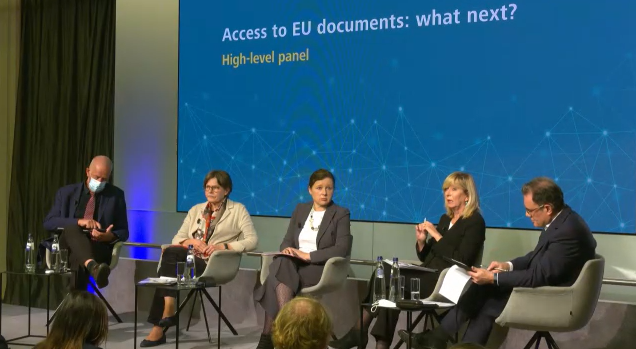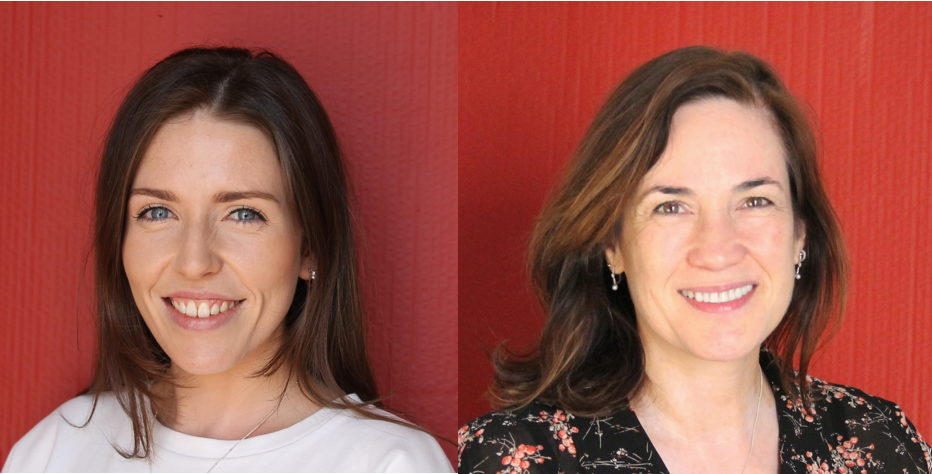Part I: In the high-level panel, everyone agrees to move forward – in their own direction.
Conference signals start of a broader call to reopen revision of EU access to documents law. First part of two reports on where the EU stands with access to documents.

On 15 November, European Ombudsman Emily O’Reilly organised a hybrid conference in Brussels on EU access to documents policy. Entitled “Access to EU documents: what next?”, the conference sought to thematise the changing technological context within which this policy operates. The current access to documents law, Regulation 104/2001, entered into force 20 years ago this year, in a world then still unacquainted with smart phones, apps, and social media. In the words of O’Reilly:
People who were born when Regulation 1049/2001 was adopted are now 20. Think of the tremendous societal change that occurred in their lifetime.
As it turns out, the conference formed the starting signal for a call for broad revision of Regulation 1049/2001 in order to, as the Ombudsman argues, align it with today’s technological realities.
Change? Yes! But what kind of change?
The conference, moderated by Brussels-based journalist James Kanter, consisted of a ‘high-level’ and an ‘expert’ panel (the latter will be covered in a follow-up blog post to appear later this week).
Before the first panel got under way, a snap poll was held. Physical and online participants were asked to vote whether a change in Regulation 1049/2001 was needed. Out of 60 participants, a whopping 77% agreed with this statement. An interesting result, given the fact that 12 years of legislative reform attempts have come to nothing, leading the Commission, last year, to even withdraw its reform proposals altogether.
With that, the first panel started. Ombudsman O’Reilly offered an opening statement. She highlighted that dealing with complaints related to access requests is one of the core activities of her office, leading her to discern certain patterns in the institutions’ manner of discharge of their transparency duties. These patterns came back in a small survey conducted among former complainants (30 respondents out of 89 invited), who overwhelmingly experienced vast delays in the institutions’ replies to their requests, and an insufficient incorporation of relevant recent case law in their justifications. She considered this one indication that a reform of Regulation 1049/2001 must be reconsidered. This position formed the starting point of the first panel.
The speakers in this panel all represented one of the three central EU institutions. Commissioner Vera Jourová offered her whole-hearted support for a reform of the regulation. Confirming her reputation as a politician with an appetite for ambitious legislative packages, she went all-in, stating that she would prefer to present a fully-fledged new act that respects the case law and reflects citizens’ new, increased information needs. Pointing out the large power wielded by the EU, she argued that “citizens, too want to have their sandwich [and eat it]”. While Jourová’s intervention suggested that she is not the member of the College of Commissioners holding the reform process back, it remained unclear what particular innovations she championed, beyond political sloganeering.
Next speaker was Reijo Kemppinen, Director-General for Communication and Information, at the Secretariat of the Council. He opined that the current access legislation “needs urgently to be looked at”. In particular, he saw what he considered a worrying trend whereby the law made it increasingly difficult for the Council to protect the efficiency of its decision making. The “blurring between legislative and non- legislative decision making” further exacerbated this problem in his view. Although he left the culprit unstated, it may be presumed that Kemppinen was referring to the Court of Justice doing the blurring in its case law. Most of those present would probably agree with Kemppinen’s assessment that the Council has gradually lost “space to think” in its decision-making procedure. However, views might differ on on whether this is a problematic development.
Heidi Hautala, Finnish MEP for the Greens and Vice President of the European Parliament, up next, certainly formed one actor to question Kemppinen’s problematisation. Remarkably, Hautala also wanted the legislation to be changed. However, she opined that the fundament of the originally adopted act was to increase citizens’ ability to participate in the EU decision-making process, and that any revision should take that objective as its starting point. In this context, Hautala considered her countryman Kemppinen’s words “slightly worrying”.
When moderator Kanter wondered whether the change of government in Germany, inter alia, could provide new impetus for a revision of Regulation 1049/2001, all speakers again reiterated their optimism in this regard. Kemppinen, a senior civil servant, estimated that there was no need for caution on his part “to state that Council would welcome a new proposal”. Hautala however urged the Commission to seek input and feedback from civil society and tap into their knowledge. O’Reilly expressed a sense of urgency:
How much time do we need? This law has been discussed for years.
She also estimated that political support for reform had grown since she entered into office in 2013.
‘More transparent than thou’ (or less?)
Political scientist Hood once mused that transparency has today become something of a religion in public institutions. “‘More-transparent-than-thou’ has become the secular equivalent of ‘holier than thou’ in modern debates over matters of organization and governance”. Indeed, all the subject’s deserved seriousness aside, a similar dynamic of taking each other to task has also been discerned between the institutions of the EU.
In this sense, the audience had only to wait for Kanter to bring up a recent news story concerning the mass deletion of tweets by Commission President Von der Leyen related to the purchase of Covid-19 vaccines. He looked towards Jourová as the Commissioner responsible for overseeing such actions: how could this have happened on her watch? Jourová responded somewhat aloof, downplaying the significance of tweets as a mode of official communication, yet pointing at the reform of internal rules concerning disclosure matters of this kind.
The institutional representatives also propounded some interesting views on the criteria for archiving information. Kemppinen, for example, stated that Council’s disclosure rate was not far off from a 100%. However, he omitted to say that large volumes of documents carrying a so-called ‘WK’ label are never placed on the register at all, leading to significant misrepresentation of the reality on the ground.
Meanwhile, Jourová somewhat cryptically revealed that the tense political times mean that EU politicians feel compelled to delete certain sensitive text messages. Yet she defended this practice by pointing out that decisions are not taken via these channels of communication. Kemppinen came to her aid by arguing that the volumes of data produced in alternative communication would be too large to meaningfully manage. Given these circumstances, he considered it correct that the responsibility lies with decision makers themselves to see to the good archiving of their communications. Kemppinen made a further challenging observation related to the transparency of the Council as a decision-making machine worthy of consideration: how to capture negotiations in such a highly complex environment?
A final important point picked up by Kanter was the question of transparency of expenditure under the newly-adopted Resilience and Recovery Facility (RRF) which aims to pull the EU out of the economic abyss created by the corona pandemic. As Kanter pointed out, this facility covers an enormous sum of money. Indeed, the RRF funds make up close to three quarters of a trillion euros, of which €338 billion are set to be non-repayable grants. This, he argued, creates a clear public interest in knowing how the money will be spent, and ensuring that it will be spent properly, with due regard for the criteria of transitioning to more digital and green solutions. The co-founders of a new civil society transparency watchdog have recently questioned whether this is the case, claiming that “business as usual isn’t good enough to ensure spending accountability”.
Jourová responded by striking a reassuring tone. The same conditions of transparency and accountability are to apply to the disbursement of these funds as apply to the regional development funds right now. (This claim is contested by the civil society watchdog, see blog post above.) Jourová feels confident that the Commission’s negotiators have this question firmly on their radar. Kemppinen was less certain that the necessary checks and balances are already in place. He considered that not anywhere near enough has been done about this issue, and has a suggestion: why not make recipients disclose visibly how they spend the money they receive?
The end of a panel is but the beginning of a conversation
The high-level panel ended with a final comment by the Ombudsman. After hearing the inputs of the three institutions’ representatives, she retained hope that things are moving along. She particularly found the words of Jourová and Hautala promising.
Though I’m still not too sure where the Council is at, to be honest.
O’Reilly urged the Council to be “transparency’s friend”. This, she considered, can help remove popular misconceptions about the functioning of the EU.
Later, it emerged that during the conference, the Ombudsman’s office had put out a press statement through its website, calling for Regulation 1049/2001 “to be modernised”, taking cognisance of new technologies, including smartphones, instant messaging and smart data. In a separate op-ed published almost simultaneously by the EU Observer, the Ombudsman argued that
this cornerstone of EU transparency [Regulation 1049/2001] comes from a radically different era, predating many modern communications tools
and consequently requires a legislative update.
The Ombudsman thus appears on a mission to reopen what has up until now a notoriously explosive legislative dossier. And while all speakers in the high-level panel agreed with her up until that point, their thinking on the right direction forward still continues to diverge considerably.
In the second post covering the Ombudsman’s conference, you can read how civil society stakeholders and a professor of EU law from the conference’s second, “expert panel” react to this initiative.
The livestream of the conference can be viewed back here.




